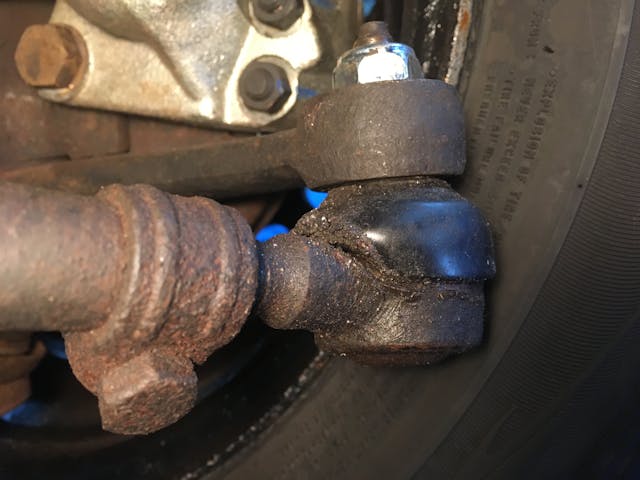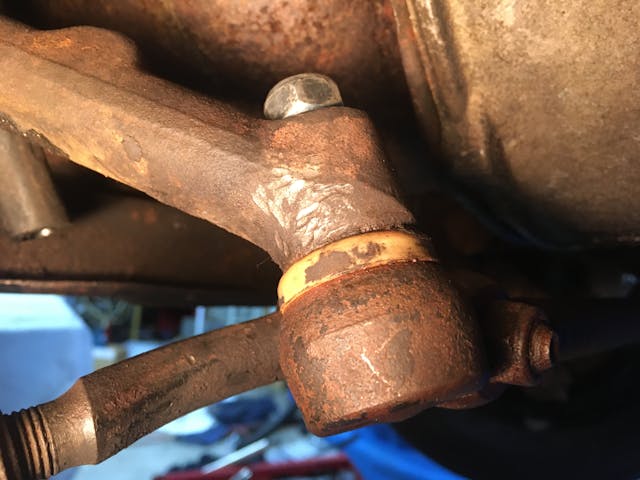Knowing when to back out doesn’t mean chickening out

First, an update on “Flirting with a Mercedes-Benz SL500 in Craigslist,” my piece from a few weeks ago about what my next car might be. Sadly, my brief infatuation with the $2800 R129 SL500 in Burlington, Vermont, ended without fulfilment in either the spiritual or acquisitional sense.
The seller texted me the VIN, and I ran a CarFax. It showed a flood event in Houston in 2001 that generated salvage titles for the next four owners, stopping with the current owner since Vermont doesn’t issue titles for cars older than 15 years. On the one hand, the car has been running for nearly 20 years since the flooding incident, so you could argue that any gremlins had likely been worked out and the history and salvage title were factored into the low asking price. On the other hand, if I bought the car, used it for a bit, and then wanted to sell it, anyone running a CarFax would see what I saw and be equally concerned.
The car needed transmission work (due to slippage in reverse), and I had no inexpensive ready solution for repairing or replacing the transmission. Plus, the car was currently unregistered, it was at least an eight-hour round trip to Burlington and back, and I began seeing other R129s with fewer red flags in the $4000–$5000 range. Thankfully, my left brain overruled my right brain. It was a fun fixation for a few days, though. I’m sure you all know what that’s like.
With that said, you might think the headline on this week’s column has to do with taking a pass on the R129, but that’s just a coincidence. Over the decades, I’ve dived into many repairs, some of which were over my head. Hell, my first repair ever on a BMW 2002 was removing and rebuilding the transmission. I pride myself on my grit, determination, scrappiness, and track record of finishing what I start. But it’s also useful to have a setting on the dial other than “all in.” One of the things I wrote in my first book is that, for many repairs, when you go into a cave and encounter a beast—something like a bolt or nut that, if it strips, is going to cause you multiple evenings of pain and /or non-trivial expense—you need to either slay it, or else back slowly out of the cave. Sometimes, you have just one turn of the wrench, one smack of the hammer, or one blow of the torch in which to make that decision. Circumstances can often make you go all in before you even know it. Learning to recognize when you’re crossing that tipping point can be incredibly useful.
And that brings us to today’s topic. Two years ago, I bought back “Bertha,” the heavily modified 1975 BMW 2002 I’d sold to a close friend back in 1988. The car then got stolen, recovered, stolen again, recovered with damage, then put into storage, where it sat for 26 years, gaining a rather dramatic patina of rust from sitting in a garage that backed onto a pond. I repurchased and resurrected the car, and it’s been a fun part of the stable ever since.

As I often write, with 11 vehicles, none of them ever get everything they need, and that includes Bertha. The car’s resurrection hinged on my being unapologetically cost-conscious about replacing only what was broken or badly worn out. Obviously I made certain the car was safe to drive, but as far as front-end work went, I limited it to verifying that the ball joints and other steering components had no play, then slipped a new set of rubber boots over the existing split boots on the tie rods.

This spring, though, when I put new tires on Bertha and began to drive it more aggressively, I noticed that there was a notchy point in the steering. When I turned left, I could feel it almost passing through a detent. I could turn the wheel past the rough spot without any real effort, but like a bump you find on your scalp, once I knew it was there, it was impossible not to notice it and feel it.
I put the car up on the lift and moved the steering components to isolate the cause. Surprisingly, with the wheels in the air, I felt absolutely nothing. But when I put a load on the wheels by lowering the car so that the tires touched the ground, the notch resurfaced. I had my wife rock the steering wheel back and forth over the spot while I laid my hands on every steering component. It appeared to be coming from the steering box itself. I posted the question to the largest BMW 2002 forum (bmw2002faq.com), and learned that this notchiness in the steering box is not uncommon with age and mileage. I made sure the box was full of gear oil and tweaked the lash adjustment slightly, but it didn’t change the notch. The only real treatment is replacement.
Good, used 2002 steering boxes have gotten pricey the past few years. I gave the last spare one I had to a friend of mine who had helped me tow a car. But by chance, another friend announced on Facebook that he was moving and liquidating his stash of 02 parts, so I grabbed what he believed to be a good used steering box for $70. When it arrived, I put the car back up on the lift and prepared to have at it.

The steering box is a bit of a pain to replace, although on paper it doesn’t sound like much. The box itself is bolted to a plate on the front subframe. The steering column is attached to the box at the top front via a splined universal joint and a rubber flex disc. The steering arm protruding from the bottom attaches to the center track rod (also called the drag link), which in turn moves the tie rods attached to both ends. The problem is that it’s difficult to separate the steering arm from the center track rod. Like a tie rod, the attachment point is a tapered rod through a hole in the steering arm, and with 45 years of adhesion, it doesn’t easily give it up. But unlike a tie rod, this attachment point doesn’t have a pliant rubber boot that’s easily pushed away to slide in a puller. Instead, the ball-in-socket is protected by a hard-plastic cover. I have a variety of ball joint, tie rod, and pitman arm pullers. I tried them all and was reminded that none of them fit around the plastic cap.

So how do you get it off? It slowly came back to me that, when I’ve done this in the past, I’ve needed to destroy the cap by cracking it and prying it off with a screwdriver, at which point you can get a puller in the crevice between the arm and the track rod, but you’ll also need to replace the track rod. However, I didn’t want to replace the track rod. It wasn’t the part that was bad. The steering box was. At least so I thought.
I looked again on bmw2002faq.com to see if there were other ideas. It was recommended that I use a torch to carefully heat the outside of the steering arm where the drag link’s tapered rod passes through it—carefully, because you don’t want to melt either the plastic cap or the rubber boot of the tie rod that’s right next to it—and then band the tapered rod out with a hammer. Unfortunately, there isn’t enough clearance to bang on the top of the rod to beat it out, but you can smack on the side of the steering arm to try to break the corrosion and dislodge it. I tried this, and not only didn’t it work but I found, surprisingly, that afterward the steering was stuck. It took me a few minutes to realize that what had happened was that, even with my carefully directing the torch at the steering arm and not at the drag link, the torch had heated up the ball in the drag link’s socket and expanded it, and it was no longer turning freely. As it cooled down, it began to move, though with a loud screeeeee. A shot of Silikroil into the gap and waiting another five minutes quieted it back down.
I thought about it carefully. Clearly, I shouldn’t do another thing until I had a replacement drag link in my hand. They’re not ungodly expensive; maybe 90 bucks shipped. In addition to the steering arm, the drag link has three other attachments. One is to the idler arm, the mirror image of the steering arm on the other side of the subframe, which has all the same removal challenges. Then there are the two tie rod attachments at the ends. As I said, these probably wouldn’t be too bad to remove; since they have rubber boots, one of my pullers could slide in place.
But then I looked at the other steering components. I noticed that the ball joints were held in by rivets, which meant they were the car’s original 45-year-old ball joints. They had no play, and their boots were intact, but still. The rubber bushings in the lower control arms were cracked from age. And there were those cracked boots on the tie rods that I’d over-booted to buy time. Really, since the center track rod wouldn’t come out without a fight, the smart thing would be to turn this steering box replacement into a full front-end refresh, because some amount of that was destined to happen whether I wanted it to or not.

But was I prepared to dive into that, now, when all I wanted to do was take out the little divot I felt in the steering on tight left turns?
In fact, no.
Back slowly out of the cave.
So, knowing when to back out doesn’t mean chickening out. It may just mean “I don’t want to commit to everything this entails at this particular moment.” Or that discretion is the better part of valor, as the old saying goes. I might get around to this project at some point, perhaps even over the winter, but not now. I’m lining up my ducks to address some vibration issues in the Lotus—new tires are on the way, as are parts and tools to adjust the rear wheel toe-in. I don’t want Bertha to monopolize the lift right now; I don’t even have all the parts I need to complete the project.
Besides, if the seller drops the price on that still-for-sale SL500, I’d need the lift to get look at the transmission.
***
Rob Siegel has been writing a column (The Hack Mechanic™) for BMW CCA Roundel magazine for 34 years and is the author of seven automotive books. His new book, The Lotus Chronicles: One man’s sordid tale of passion and madness resurrecting a 40-year-dead Lotus Europa Twin Cam Special, is now available on Amazon (as are his other books), or you can order personally-inscribed copies from Rob’s website, robsiegel.com.

